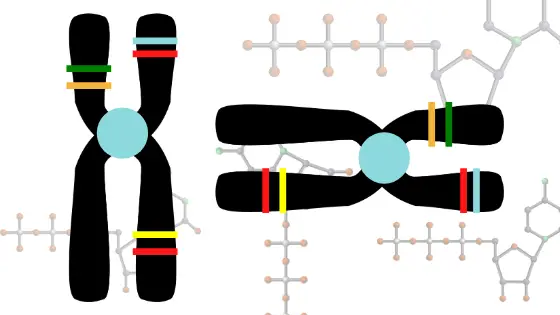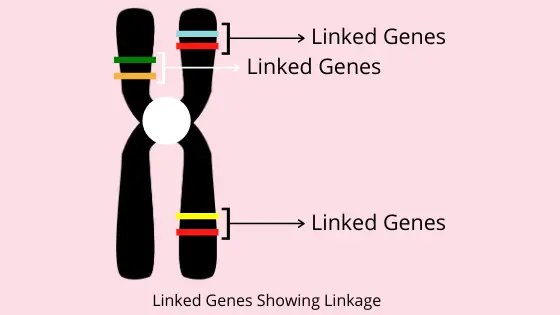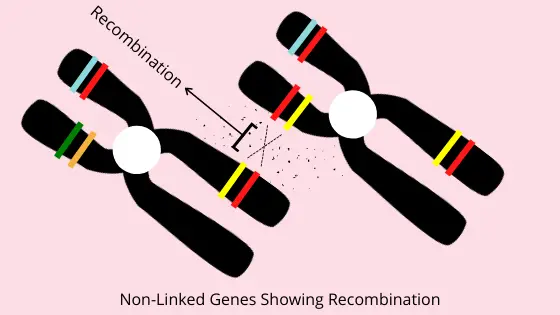Difference Between Linkage and Recombination – (Linkage Vs. Recombination)
In this post, we will know about the key differences between Linkage and Recombination.
After reading this post, you can perfectly differentiate the two of these very clearly.

Both Linkage and recombination are two of the most important concept in genetic and molecular biology.
There are various relationships and differences between the two which makes it a bit confusing for first-time learners.
We all know that genes are the chunks of DNA that are found in chromosomes. A single chromosome can have hundreds to thousands of genes.
It’s the location in a chromosome where a specific gene is located is known as the locus. A locus is a genetic unique address of a particular gene in a chromosome.
Two or more genes that are present in a chromosome, when close to each other, can be related and strongly linked. Or, you can say if two or more genes are very far from each other then there will be less relations and links between the two. These are the main concepts on which linkage and recombination work.
Linkage describes the occurrence of two different genes as one unit on the same chromosome because the genes are located very close to each other.
Whereas, recombination describes the mixing up of two different genes located very far from each other in homologous or non-homologous chromosomes via. the process called crossing over.
Linkage and recombination are the phenomena that describe the inheritance of genes.
Linkage shows parental characters in the offspring and is the evidence of inheritance. Whereas, recombination shows non-parental characters in the offspring and is the evidence of variation.
Comparison Chart: Linkage Vs. Recombination
| No. | Linkage | Recombination |
|---|---|---|
| 1. | The tendency of genes (DNA sequences) to stay together in a chromosome is called genetic linkage. | The tendency of the genes (DNA sequences) to recombine and change its location in/between the chromosomes is called genetic recombination. |
| 2. | This happens when the two genes are very close to each other. | This happens when the two genes are located very far from each other. |
| 3. | This happens in the same chromatid of the chromosome. | This can happen on the same chromosome or between the non-sister chromatids of non-homologous chromosomes. |
| 4. | Linkage ensures to keep the genes in a chromosome to inherit together. | Recombination ensures the formation of new combinations of alleles that when inherited separately leads to variation. |
| 5. | It explains genetic inheritance properly. | It explains genetic variation properly. |
| 6. | Linkage occurs between linked genes. Linked gens are very close to each other. | Recombination occurs between non-linked genes. Non-linked genes are very far away from each other. |
| 7. | The recombinant frequency of linked genes is always less than 50%. | The recombinant frequency of non-linked genes is always more than 50%. |
| 8. | The strength of linkage between two genes is inversely proportional to the distance between them in the chromosome. | The probability of recombination between two genes is directly proportional to the distance between them in the chromosome. |
| 9. | The strength of linkage between two genes increases with the decrease in distance between them. | The chance of recombination between two genes decreases with the decrease in distance between them. |
| 10. | Linkage decreases the chances of variation in living organisms. | Recombination increases the chances of variation in living organisms. |
| 11. | Linkage shows parental traits in the offspring. | Recombination shows non-parental traits in the offspring. |
| 12. | There are 2 types of linkage: Complete Linkage, and Incomplete Linkage | There are 2 types of Recombination: Homologous Recombination, and Non-Homologous Recombination |
| 13. | Linkage doesn’t show independent assortment. | Recombination shows independent assortment. |

Definition of Linkage
Linkage simply means the link between two genes present on the same chromosome. The more strong the linkage is the more probably the genes are inherited together for more than two generations.
Genes are said to be linked when genes for different traits are located in similar chromosomes and hence are tied to each other.
The linked genes tend to inherit together as a unit during the cell division. That is when the genes go into gametes, the allele received for one gene does affect the allele received for the other.
In simple words, although each of the two linked genes expresses different genetic traits but, both of the linked genes act as a unit in expressing the genetic traits in the living body.
If the linkage is strong enough then the chances of recombination via. the process of crossing over is very less.
And, if the linkage isn’t powerful enough, that is due to a large distance between the two genes, then the chances of recombination via. the process of crossing over is very much high.
The genes present in the same chromosomes tend to be inherited together and so are called linked genes and this phenomenon is known as linkage. The recombinant frequency of linked genes is less than 50%.
Example: In humans, genes for hair color and eye color are linked. So you will find that certain hair and eye colors tend to be inherited together, such as blonde hair with blue eyes and brown hair with brown eyes.

Definition of Recombination
Recombination simply means to combine two very different things and make it work as one.
In genetics, recombination is a process of producing new combinations of alleles (different forms of genes) by the recombination of parental genes. This results in variation in the offspring.
It is also referred to as genetic recombination, as there is an exchange of genetic material (DNA) between two different chromosomes or between different regions of the same chromosome.
Recombination usually occurs between non-linked genes. That is, recombination is usually seen between those genes where linkage doesn’t occur or the frequency of linkage is very very low.
Non-linked genes are those genes that are found on different chromosomes or on the same chromosomes and show a huge distance between each other.
Non-linked genes will not be affected by the process of recombination by crossing over and will obey the law of independent assortment.
Recombination can be seen during the Prophase-I stage of Meiosis when the exchange of chromosomes segments between non-sister chromatids occurs. This creates recombinant chromosomes that have a different combination of the gene than either parent.
Non-linked genes can exhibit 50% or more recombination frequency.
Example: The rearrangement of immunoglobulin genes in Vertebrate animals to form immunoglobulins that may not match to that of the parents.
Key Differences Between Linkage and Recombination
1. Linkage occurs between two genes that are very close to each other. And, recombination occurs between two genes that are located very far from each other.
2. Linked genes are two different genes at different loci (single: locus) that don’t separate and get inherited to the next generation. Whereas, recombined genes are two different genes at different loci of homologous or non-homologous chromosomes that are the altered versions of the parental genes that get inherited.
3. As the distances between two genes increases, the linkage decreases, and the recombination by crossing over increases. But, when the distance decreases the tendency of recombination also decreases.
4. Linkage shows the inheritance of same parental characteristics for more than two generation. Whereas, Recombination shows the variation of parental characteristics to express non-parental traits in the next generation.
5. Linkage is a strict exception to the law of independent assortment. Whereas, recombination is a piece of evidence to the law of independent assortment.
6. In linkage, two or more genes linked together are always inherited together in the same combination for more than two generations. Whereas, in recombination, the genetic material is exchanged between different organisms (between male and female in case of sexual reproduction) which leads to the production of offsprings with the combination of traits.
Conclusion
Both Linkage and Recombination are two very important concepts in gene expression of both asexual and asexual reproduction organisms.
Recombination highly determines the diversity of sexually reproducing organisms. Recombination is one of the key reasons for genetic variation between different organisms.
Linkage and Recombination, both are observed in eukaryotes and prokaryotes. These are very important steps in every living organism.
Linkage helps to keep the genes together in the same chromosome, whereas recombination is the process where DNA segments separate during crossing over in meiosis.
Genetic recombination and recombinational DNA repair also occur in bacteria and archaea, which use asexual reproduction.
